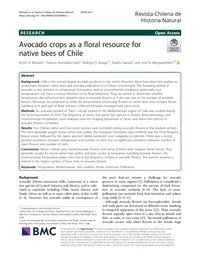Mostrar el registro sencillo de la publicación
Avocado crops as a floral resource for native bees of Chile
| dc.contributor.author | Monzón-Godoy, Víctor | |
| dc.contributor.author | Avendaño, Patricio | |
| dc.contributor.author | Araujo-Oliveira, Rodrigo | |
| dc.contributor.author | Garrido, Rubén | |
| dc.contributor.author | Mesquita-Neto, José N. | |
| dc.date.accessioned | 2020-10-20T12:26:35Z | |
| dc.date.available | 2020-10-20T12:26:35Z | |
| dc.date.issued | 2020 | |
| dc.identifier.uri | http://repositorio.ucm.cl/handle/ucm/3111 | |
| dc.description.abstract | Background: Chile is the second largest avocado producer in the world. However, there have been few studies on interactions between native bees and avocado pollination in a Chilean environment. The flowering period of avocado is very sensitive to temperature fluctuations and so environmental conditions, particularly cool temperatures, can have a strong influence on its floral behaviour. Thus, we aimed to determine whether temperature also influences bee visitation rates to avocado flowers or if this was due to the number of available flowers. Moreover, we proposed to verify the attractiveness of avocado flowers to native bees and compare flower handling time and type of floral resource collected between managed and native bees. Methods: An avocado orchard of “Hass” cultivar located in the Mediterranean region of Chile was studied during the flowering season of 2016. The frequency of exotic and native bee species in flowers, floral phenology, and environmental temperature were analysed, and the foraging behaviours of exotic and native bee species in avocado flowers compared. Results: Five Chilean native and two exotic species were recorded visiting avocado flowers at the studied orchard. The bees generally sought nectar rather than pollen. The European honeybee (Apis mellifera) was the most frequent flower visitor, followed by the native species Colletes cyanescens and Cadeguala occidentalis. There was a strong positive correlation between temperature and number of visits, but no significant correlation between number of open flowers and number of visits. Conclusions: Native Chilean bees visited avocado flowers and some of them were frequent floral visitors. They generally sought for nectar rather than pollen and were as fast as honeybees handling avocado flowers. The environmental temperature plays a key role in the frequency of bees in avocado flowers. The warmer weather is related to the higher number of bees visits to avocado flowers. | es_CL |
| dc.language.iso | en | es_CL |
| dc.rights | Atribución-NoComercial-SinDerivadas 3.0 Chile | * |
| dc.rights.uri | http://creativecommons.org/licenses/by-nc-nd/3.0/cl/ | * |
| dc.source | Revista Chilena de Historia Natural, 93 | es_CL |
| dc.subject | Temperature | es_CL |
| dc.subject | Mediterranean | es_CL |
| dc.subject | Apis mellifera | es_CL |
| dc.subject | Persea americana | es_CL |
| dc.subject | Pollination | es_CL |
| dc.title | Avocado crops as a floral resource for native bees of Chile | es_CL |
| dc.type | Article | es_CL |
| dc.ucm.facultad | Facultad de Ciencias Básicas | es_CL |
| dc.ucm.indexacion | Scopus | es_CL |
| dc.ucm.indexacion | Isi | es_CL |
| dc.ucm.indexacion | Scielo | es_CL |
| dc.ucm.doi | doi.org/10.1186/s40693-020-00092-x | es_CL |



